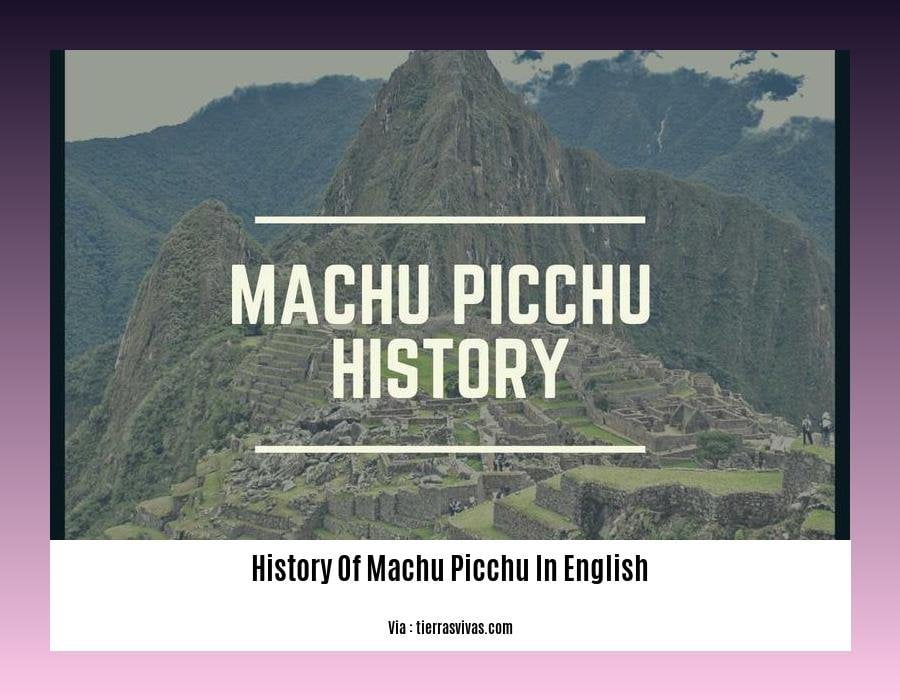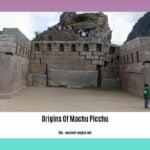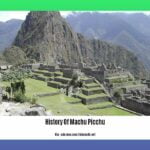Embark on a journey through time as we unravel the captivating history of Machu Picchu in English. This enigmatic Inca citadel, nestled amidst the soaring Andes Mountains, holds secrets that have captivated explorers and historians for centuries. Join us as we delve into the rich tapestry of Machu Picchu’s past, uncovering the ingenuity, culture, and legacy of the ancient Inca civilization. [- A Journey Through Time: History of Machu Picchu in English]
Key Takeaways:
- Machu Picchu is an ancient Inca site built in the 15th century.
- It is located high in the Andes Mountains of Peru.
- The Incas built and lived in Machu Picchu from around 1200 to 1450 AD.
- Machu Picchu was built during the height of the Inca Empire.
- It was abandoned about 100 years after it was built, possibly due to the Spanish conquest.
History Of Machu Picchu In English
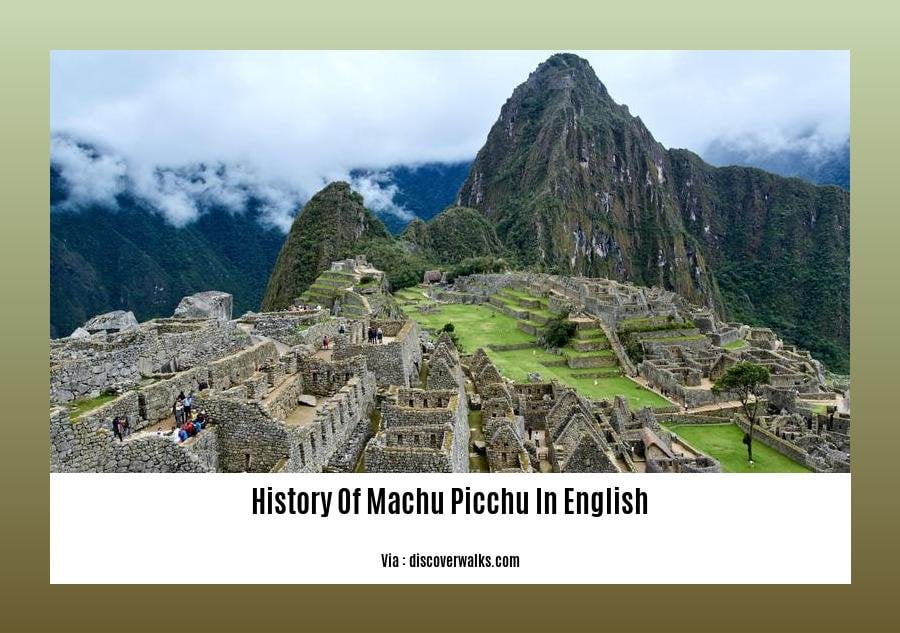
Nestled amidst the Peruvian Andes lies Machu Picchu, a UNESCO World Heritage Site that stands as a testament to the ingenuity of the Inca Empire. Its captivating history and awe-inspiring ruins draw explorers and history enthusiasts from around the globe.
Construction and Purpose
The construction of Machu Picchu commenced around 1450 AD, during the reign of the Inca emperor Pachacuti Inca Yupanqui. It was strategically built on a mountain ridge, overlooking the Urubamba River and the surrounding valleys. Historians believe Machu Picchu served multiple purposes, including:
Religious Center: With its temples, stone altars, and sacred fountains, Machu Picchu was likely a place of religious ceremonies and rituals.
Royal Estate: The presence of luxurious palaces and gardens suggests that Machu Picchu may have been an exclusive retreat for the Inca elite.
Abandonment and Rediscovery
Around 100 years after its construction, Machu Picchu was mysteriously abandoned by the Incas. The reasons for this remain unknown, but some theories suggest the possibility of disease outbreaks, warfare, or a shift in political power.
In 1911, American explorer Hiram Bingham III stumbled upon Machu Picchu and brought it to the attention of the Western world. Since then, the site has become a popular tourist destination, attracting millions of visitors each year.
Exploring the History
Immerse yourself in Machu Picchu’s History Of Machu Picchu In English through guided tours, interactive exhibitions, and archaeological research. Discover the secrets of the Inca Empire, unraveling the mysteries of Machu Picchu’s construction, abandonment, and rediscovery.
Legacy and Significance
Machu Picchu serves as a living testament to the architectural prowess of the Inca civilization. It offers valuable insights into the cultural, religious, and political practices of the ancient inhabitants. The site continues to captivate and inspire, ensuring its legacy as one of the most iconic landmarks in the world.
Unravel the enigmatic past of this iconic Andean citadel by exploring our comprehensive guide to the history of Machu Picchu. Discover the captivating story of Machu Picchu, from its enigmatic origins to its grandeur during the Incan Empire. Delve into the origins of Machu Picchu and be captivated by the secrets and mysteries surrounding this architectural marvel.
Abandonment and Rediscovery
The abandonment of Machu Picchu by the Incas around a hundred years after its construction remains an enigma. Speculations range from Spanish invasion to deadly diseases, but the true reason is still debated.
In 1911, Hiram Bingham, an American historian stumbled upon the ruins, launching the site into global fame. Bingham’s rediscovery sparked widespread fascination with the lost city’s architectural marvels and its role in Inca civilization.
Key Takeaways:
- Machu Picchu’s abandonment remains a mystery, with various theories proposed.
- American historian Hiram Bingham’s rediscovery of the site in 1911 brought it to world attention.
- The reasons behind Machu Picchu’s abandonment and Bingham’s rediscovery continue to captivate researchers and enthusiasts alike.
Sources:
- Machu Picchu: An Inspirational Guide to the Lost City
- Machu Picchu | History, Facts, Maps, Elevation, Country, & Photos
Exploration and the Enduring Legacy of Machu Picchu
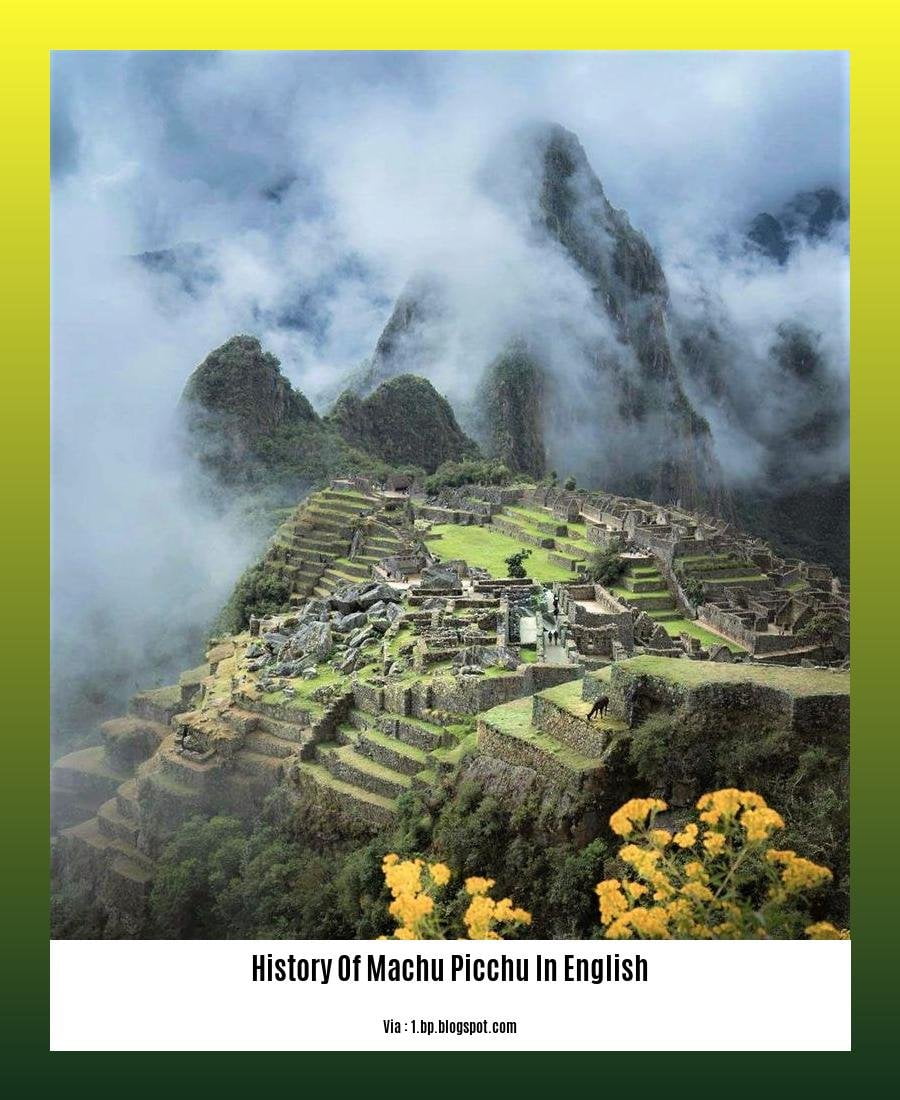
Machu Picchu, a breathtaking UNESCO World Heritage site, stands as a testament to the ingenuity and cultural legacy of the ancient Incas. Nestled amidst a verdant tropical mountain forest high above the Urubamba River, Machu Picchu is a captivating blend of natural beauty and historical significance.
Key Takeaways:
- Designated as a UNESCO World Heritage site in 1983 and one of the New Seven Wonders of the World in 2007.
- Built around 1450 AD as a royal estate or religious retreat for the Inca elite.
- Abandoned around 100 years later, possibly due to the arrival of Spanish conquistadors.
- Rediscovered in 1911 by American explorer Hiram Bingham III and became a popular tourist destination.
Historical Murals and Artifacts:
As you explore Machu Picchu, you’ll find yourself surrounded by ancient walls, temples, and palaces. Take the time to admire the intricate stonework and search for fragments of pottery and textiles that offer a glimpse into the daily lives of the Incas.
Astronomical Knowledge:
The Incas were skilled astronomers, and Machu Picchu reflects their deep understanding of the stars and planets. Look for the Intihuatana, a stone structure believed to have been used for astronomical observations.
Agricultural Terraces:
The surrounding mountainsides were once home to a complex system of agricultural Inca stone enclosures where the Incas planted crops. Discover how this innovative agricultural system allowed them to cultivate food in challenging mountain terrain.
Local Culture and Traditions:
Today, Machu Picchu is not just a historical site but also a place of great cultural significance. Visit nearby villages and learn about the traditions and customs of the local Quechua people, descendants of the Incas.
Preservation and the Future:
Machu Picchu is a fragile ecosystem, so it’s important to be respectful of the environment. Pack out what you pack in, stay on designated trails, and help preserve this treasured site for generations to come.
Sources:
Machu Picchu
Machu Picchu | History, Culture, Geography, & Points of Interest
Preservation and Conservation: Protecting Machu Picchu’s Timeless Legacy
Machu Picchu, the iconic Incan citadel nestled amidst the Peruvian Andes, beckons travelers with its captivating history and architectural wonders. Its enduring allure stems from the remarkable preservation and conservation efforts that have safeguarded this ancient treasure for generations.
Threats to Machu Picchu’s Preservation
Despite its secluded location, Machu Picchu faces numerous threats, including:
- Natural disasters: Earthquakes and landslides can cause severe damage to the fragile site.
- Climate change: Rising temperatures and changing precipitation patterns can lead to erosion and instability.
- Mass tourism: The influx of visitors exerts strain on the infrastructure and ecosystem.
Conservation Initiatives
Recognizing the urgency of preserving Machu Picchu, Peruvian authorities have implemented stringent conservation measures:
- Tourist management: Limiting visitor numbers, regulating access, and implementing strict guidelines for exploration.
- Infrastructure reinforcement: Strengthening structures, installing drainage systems, and improving access trails.
- Environmental monitoring: Tracking weather patterns, vegetation growth, and wildlife populations to mitigate potential risks.
Benefits of Preservation and Conservation
By safeguarding Machu Picchu, we ensure that generations to come can:
- Witness the architectural brilliance and cultural heritage of the Incan civilization.
- Appreciate the natural beauty and biodiversity of the surrounding environment.
- Learn from the past and gain insights into human resilience and ingenuity.
Key Takeaways:
- Machu Picchu’s preservation and conservation are paramount to protect its timeless legacy.
- Threats such as natural disasters, climate change, and mass tourism prompt the need for stringent measures.
- Conservation initiatives focus on tourist management, infrastructure reinforcement, and environmental monitoring.
- Preserving Machu Picchu safeguards its historical, cultural, and environmental significance for future generations.
Sources:
- UNESCO World Heritage Centre: Historic Sanctuary of Machu Picchu
- National Geographic: Machu Picchu: Preserving the Lost City of the Incas
FAQ
Q1: When was Machu Picchu built?
A1: Machu Picchu was built in the mid-15th century during the height of the Inca Empire.
Q2: Why was Machu Picchu abandoned?
A2: The exact reason for Machu Picchu’s abandonment remains unknown, but it may have been due to factors such as disease, warfare, or the arrival of the Spanish conquistadors.
Q3: Who discovered Machu Picchu?
A3: Machu Picchu was rediscovered in 1911 by American historian Hiram Bingham.
Q4: What is the significance of Machu Picchu?
A4: Machu Picchu is a UNESCO World Heritage Site and is considered one of the most important archaeological sites in the world, offering insights into the ingenuity and engineering skills of the ancient Incas.
Q5: How can I visit Machu Picchu?
A5: Machu Picchu is accessible by train or hiking, and it is recommended to book a tour or hire a guide to fully appreciate the history and significance of the site.
- Amazing March Fun Facts: Unveiling History & Celebrations - April 15, 2025
- Master how to write height: A complete guide - April 15, 2025
- How High Are Your Standards Test: Find Your Perfect Match Now - April 15, 2025
